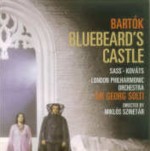I recall being enormously impressed by the look and feel of this performance when it first appeared on VHS many years ago; revisiting it on DVD I can say that much of it is still quite beautiful, but it is far more visually naïve than I remembered. It is a film directed by Miklos Szinetar, with the characters lip-synching (very obviously, for the most part) to a pre-recorded soundtrack. The costumes for the pair–a lovely, diaphanous, nightgown-like dress for Judith and a really stupid, Ming-the-Merciless (or Star Wars evil) black leatherette thing for Bluebeard–are nothing if not theatrical (and are by Judit Schäffer).
Gabor Bachmann is credited as set designer, and he presents quite a fiesta, door-by-door. The castle is more like a gigantic cave, carved out of rock; some of the rooms have columned walls. Despite a certain sinister overall feel, each room is such a “set”, and we get to see it so clearly (unlike the effect it might have if we were in a large theater) that it fails to affect us in the right way. The torture chamber, filled with chains and blood, seems to go on forever; since it isn’t closed-in, it’s not very menacing. Bluebeard’s treasury, shining brilliantly with jewels, unfortunately features gigantic, hanging, boulder-like diamonds. The blood never looks real anywhere.
The garden (fourth door) is beautifully trellised with multi-colored flowers; look too carefully and you can see that they are plastic. And the remarkable fifth door–Bluebeard’s “vast dominions”–is a really shabby affair, with nothing but a cyclorama of clouds and sky and Bluebeard standing imperiously before it. The lake of tears, in smoky white, and the vision of Bluebeard’s former wives–each of whom in close up is also Sylvia Sass, who sings Judith–work well.
Georg Solti’s conducting and the playing of the London Philharmonic are mightily impressive. Vigilantly full and deep, mysterious and grand, the score emerges viscerally as it should, creating the atmosphere and situations all by itself, more successfully than the sets and costumes. The sound is better than it was in its original release, and Bartók’s fascinating instrumentation can be heard clearly; the creepy harp arpeggios can make the hair on the back of your neck stand up. If Solti’s leadership lacks anything it’s the sense of sadness that permeates the score.
Sylvia Sass, a soprano Judith, finds the dark tones to express both the character’s resolve and horror; in fact it is her upper register that is unreliable, and her high C at the fifth door is nasty and truncated. She looks beautiful and reads a certain determined ferocity into the character early on; it’s an interesting approach and makes Judith’s cowering later more interesting. Kolos Kovats, with ridiculous painted-on eyebrows, sings handsomely as Bluebeard, but he is entirely impassive and the endless close-ups of him do not help.
This is currently the only available Bluebeard on video; a VHS version with Robert Lloyd and Elizabeth Lawrence is out of print. This is one of those operas that works brilliantly as a sound-only recording, so I can still recommend the Christa Ludwig/Walter Berry performance on Decca as a first choice. But for those who want video, this one will certainly hold your interest, and the music is well served. The sound (LPCM Stereo and DTS 5.1 Surround), as mentioned above, is excellent and the picture is good enough but not quite up to today’s standards. There are subtitles in all major European languages and Chinese. You won’t be bored.
































